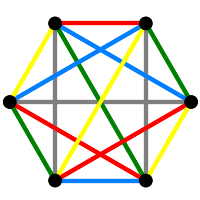Section4.1Distance Regularity
First some code to allow us to test if a graph is distance regular. The main use of this is to provide a test that some graph we have constructed is distance regular.
If \(X\) is distance-regular, then the distance partition is equitable and the quotient matrix with respect to this partition is the same for all vertices.
We use the Kneser graphs as a test case, though we must relabel the vertices to convert them from sets to integers.
If the partition is not equitable, the response would be a simple False.
There is a built-in command in sage is_distance-regular() which we would normally use in place of the above, but we wanted to demonstrate the use of is_equitable(). We will use the built-in command in the next section.
Many distance-regular graphs are distance-transitive. We can test for this by verifying that our graph is vertex transitive and the number of orbits of the stabilizer of a vertex is the diameter plus one.
The Kneser graph has a perfect 1-code—a set of seven vertices pairwise at distance three. If we delete the vertices in a perfect 1-code, the resulting graph is the Coxeter graph which is a distance-regular cubic graph. It is not too hard to see that a perfect 1-code will be a coclique of size seven that is maximal under inclusion. So we can find one and construct the Coxeter graph as follows.
We confirm that \(Y\) has girth seven, an increase of one from the girth of \(X\). You might verify that \(Y\) is distance-transitive.
